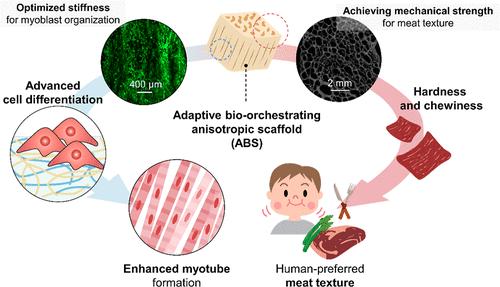Bio-Orchestration of Cellular Organization and Human-Preferred Sensory Texture in Cultured Meat
IF 15.8
1区 材料科学
Q1 CHEMISTRY, MULTIDISCIPLINARY
引用次数: 0
Abstract
For cultured meat to effectively replace traditional meat, it is essential to develop scaffolds that replicate key attributes of real meat, such as taste, nutrition, flavor, and texture. However, one of the significant challenges in replicating meat characteristics with scaffolds lies in the considerable gap between the stiffness preferred by cells and the textural properties desired by humans. To address this issue, we focused on the microscale environment conducive to cell growth and the macro-scale properties favored by humans. This led to the development of the adaptive bio-orchestrating anisotropic scaffold (ABS), which satisfies both cellular and human requirements. The ABS is produced using the anisotropic freeze-initiated ion coordination method, which sequentially aligns and enhances the fibril structure of food-derived proteins, effectively bridging the gap between cellular and culinary perspectives. Notably, the microenvironments of the ABS exhibited exceptional myoblast cell differentiation, with macro-scale 3D mechanical textures that are consistent regardless of the chewing direction, due to the aligned fibril and cell structure. The ABS containing bovine myotubes demonstrated a mechanical texture nearly identical to that of beef sirloins.

培养肉中细胞组织的生物协调和人类偏好的感官结构
为了有效地取代传统肉类,必须开发出能够复制真正肉类的关键属性的支架,如味道、营养、风味和质地。然而,用支架复制肉类特征的一个重大挑战在于细胞偏好的刚度与人类所需的纹理特性之间存在相当大的差距。为了解决这一问题,我们将重点放在有利于细胞生长的微尺度环境和人类青睐的宏观尺度特性上。这导致了适应性生物协调各向异性支架(ABS)的发展,它同时满足细胞和人体的需求。ABS是使用各向异性冷冻启动离子配位方法生产的,该方法顺序排列并增强了食物来源蛋白质的纤维结构,有效地弥合了细胞和烹饪观点之间的差距。值得注意的是,ABS的微环境表现出异常的成肌细胞分化,由于排列的纤维和细胞结构,无论咀嚼方向如何,其宏观三维机械纹理都是一致的。含有牛肌管的ABS显示出与牛里脊几乎相同的机械纹理。
本文章由计算机程序翻译,如有差异,请以英文原文为准。
求助全文
约1分钟内获得全文
求助全文
来源期刊

ACS Nano
工程技术-材料科学:综合
CiteScore
26.00
自引率
4.10%
发文量
1627
审稿时长
1.7 months
期刊介绍:
ACS Nano, published monthly, serves as an international forum for comprehensive articles on nanoscience and nanotechnology research at the intersections of chemistry, biology, materials science, physics, and engineering. The journal fosters communication among scientists in these communities, facilitating collaboration, new research opportunities, and advancements through discoveries. ACS Nano covers synthesis, assembly, characterization, theory, and simulation of nanostructures, nanobiotechnology, nanofabrication, methods and tools for nanoscience and nanotechnology, and self- and directed-assembly. Alongside original research articles, it offers thorough reviews, perspectives on cutting-edge research, and discussions envisioning the future of nanoscience and nanotechnology.
 求助内容:
求助内容: 应助结果提醒方式:
应助结果提醒方式:


